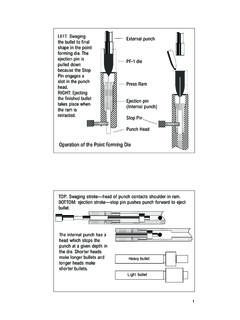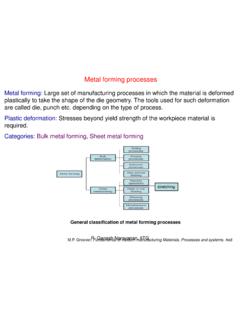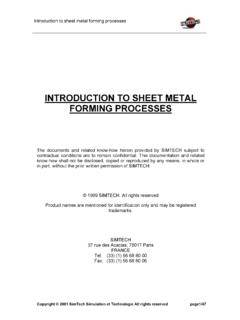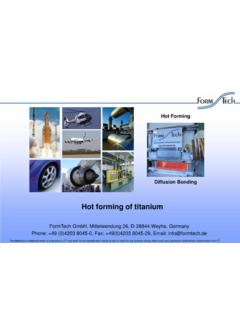Transcription of FactSheet - Occupational Safety and Health Administration
1 What types of machine components are hazardous?The following types of mechanical components present amputation hazards: Point of operation the area of a machine where it performs work on material. Power-transmission apparatuses flywheels, pulleys, belts, chains, couplings, spindles, cams, and gears in addition to connecting rods and other machine components that transmit energy. Other moving parts machine components that move during machine operation such as reciprocating, rotating, and transverse moving parts as well as auxiliary machine kinds of mechanical motion are hazardous?All mechanical motion is potentially hazardous. In addition to in-running nip points ( pinch points ) which occur when two parts move together and at least one moves in a rotary or circular motion that gears, rollers, belt drives, and pulleys generate the following are the most common types of hazardous mechanical motion: Rotating circular movement of couplings, cams, clutches, flywheels, and spindles as well as shaft ends and rotating collars that may grip clothing or otherwise force a body part into a dangerous location.
2 Reciprocating back-and-forth or up-and-down action that may strike or entrap a worker between a moving part and a fixed object. Transversing movement in a straight, continuous line that may strike or catch a worker in a pinch or shear point created between the moving part and a fixed object. Cutting action generated during sawing, boring, drilling, milling, slicing, and slitting. Punching motion resulting when a machine moves a slide (ram) to stamp or blank metal or other material. Shearing movement of a powered slide or knife during metal trimming or shearing. Bending action occurring when power is applied to a slide to draw or form metal or other there any OSHA standards that cover amputation hazards in the workplace?
3 Yes. The Occupational Safety and Health Adminis-tration (OSHA) has the following standards in Title 29 of the Code of Federal Regulations (CFR) to pro-tect workers from amputations in the workplace: 29 CFR Part 1910 Subparts O and P cover machinery and machine guarding. 29 CFR 1926 Subpart I covers hand tools and powered tools. 29 CFR Part 1928 Subpart D covers agricultural equipment. 29 CFR Part 1915 Subparts C, H, and J; 29 CFR Part 1917 Subparts B, C, and G; and 29 CFR Part 1918 Subparts F, G, and H cover maritime can employers do to help protect workers from amputations?You should be able to recognize, identify, manage, and control amputation hazards commonly found in the workplace such as those caused AmputationsAmputations are some of the most serious and debilitating workplace injuries.
4 They are widespread and involve a variety of activities and equipment. Amputations occur most often when workers operate unguarded or inadequately safeguarded mechanical power presses, power press brakes, powered and non-powered conveyors, printing presses, roll-forming and rollbending machines, food slicers, meat grinders, meat-cutting band saws, drill presses, and milling machines as well as shears, grinders, and slitters. These injuries also happen during materials handling activities and when using forklifts and doors as well as trash compactors and powered and non-powered hand tools. Besides normal operation, the following activities involving stationary machines also expose workers to potential amputation hazards: setting up, threading, preparing, adjusting, cleaning, lubricating, and maintaining machines as well as clearing FS-3508 04/2012by mechanical components of machinery, the mechanical motion that occurs in or near these components, and the activities that workers perform during mechanical operation.
5 Work practices, employee training, and admin-istrative controls can help prevent and control amputation hazards. Machine safeguarding with the following equipment is the best way to control amputations caused by stationary machinery: Guards provide physical barriers that prevent access to hazardous areas. They should be secure and strong, and workers should not be able to bypass, remove, or tamper with them. Guards should not obstruct the operator s view or prevent employees from working. Devices help prevent contact with points of operation and may replace or supplement guards. Devices can interrupt the normal cycle of the machine when the operator s hands are at the point of operation, prevent the operator from reaching into the point of operation, or withdraw the operator s hands if they approach the point of operation when the machine cycles.
6 They must allow safe lubrication and maintenance and not create hazards or interfere with normal machine operation. In addition, they should be secure, tamper-resistant, and are responsible for safeguarding machines and should consider this need when purchasing machinery. New machinery is usually available with safeguards installed by the manufacturer. You can also purchase appropriate safeguards separately or build them certain jobs particularly hazardous for some employees?Yes. Under the Fair Labor Standards Act, the Secretary of Labor has designated certain nonfarm jobs as especially hazardous for employees under the age of 18. These workers generally are prohibited from operating band saws, circular saws, guillotine shears, punching and shearing machines, meatpacking or meat-processing machines, paper products machines, woodworking machines, metal-forming machines, and meat RightsWorkers have the right to: Working conditions that do not pose a risk of serious harm.
7 Receive information and training (in a language and vocabulary the worker understands) about workplace hazards, methods to prevent them, and the OSHA standards that apply to their workplace. Review records of work-related injuries and illnesses. File a complaint asking OSHA to inspect their workplace if they believe there is a serious hazard or that their employer is not following OSHA s rules. OSHA will keep all identities confidential. Exercise their rights under the law without retaliation, including reporting an injury or raising Health and Safety concerns with their employer or OSHA. If a worker has been retaliated against for using their rights, they must file a complaint with OSHA as soon as possible, but no later than 30 additional information, see OSHA s Workers page ( ).
8 How to Contact OSHAU nder the Occupational Safety and Health Act of 1970, employers are responsible for providing safe and healthful workplaces for their employees. OSHA s role is to help ensure these conditions for America s working men and women by setting and enforcing standards, and providing training, education and assistance. For more information, visit www. or call OSHA at 1-800-321-OSHA (6742), TTY is one in a series of informational fact sheets highlighting OSHA programs, policies or standards. It does not impose any new compliance requirements. For a comprehensive list of compliance requirements of OSHA standards or regulations, refer to Title 29 of the Code of Federal Regulations.
9 This information will be made available to sensory-impaired individuals upon request. The voice phone is (202) 693-1999; teletypewriter (TTY) number: (877) 889-5627.















